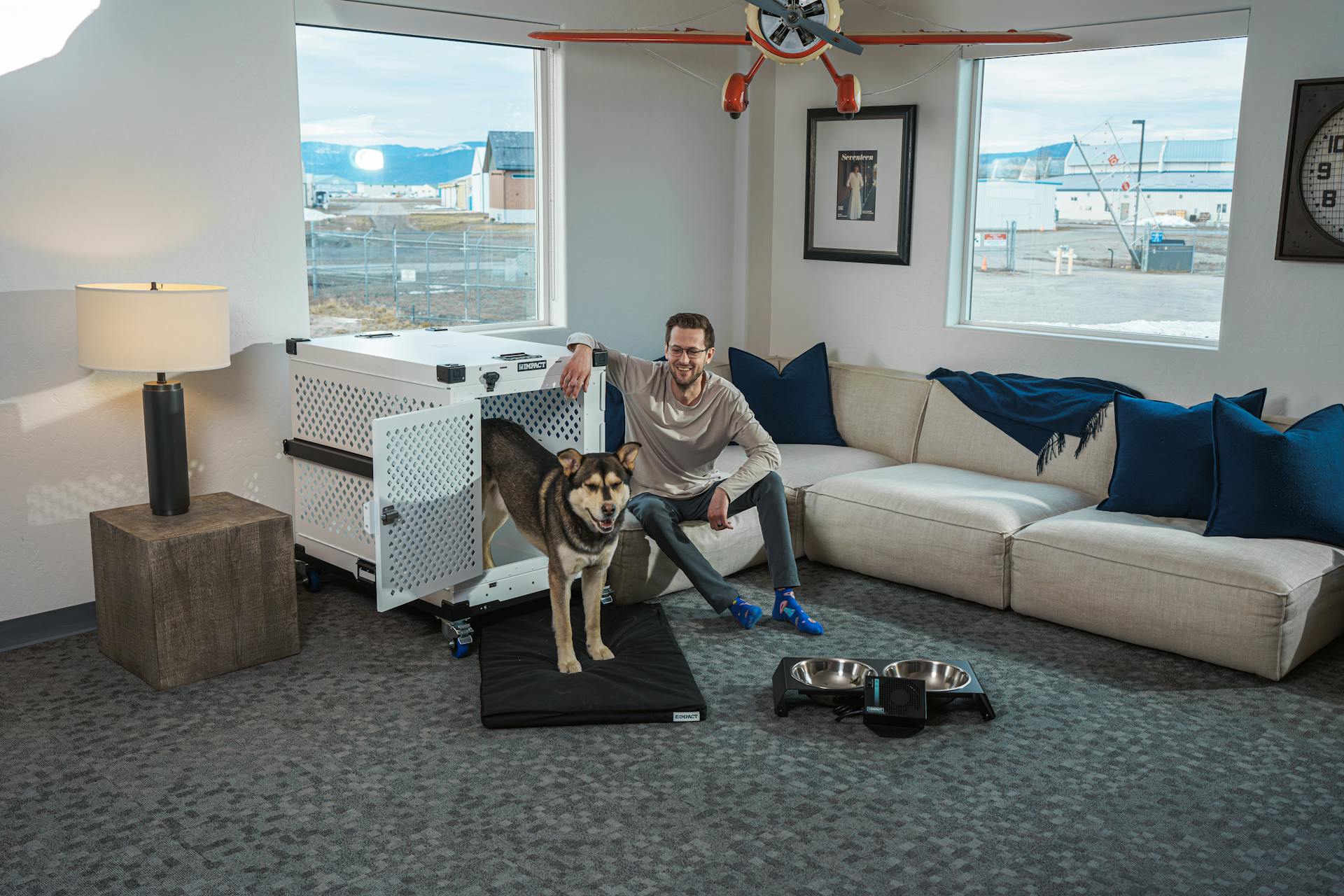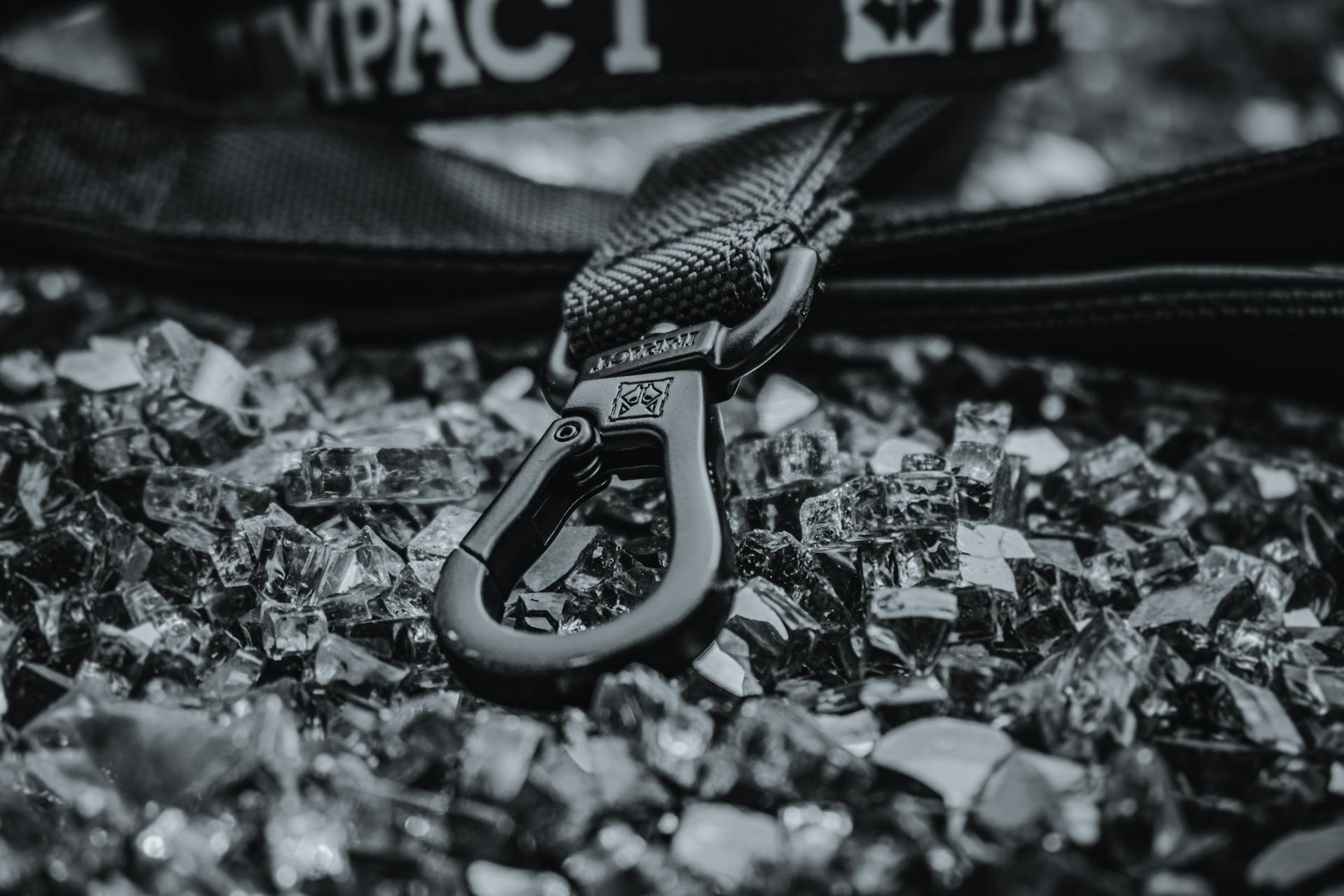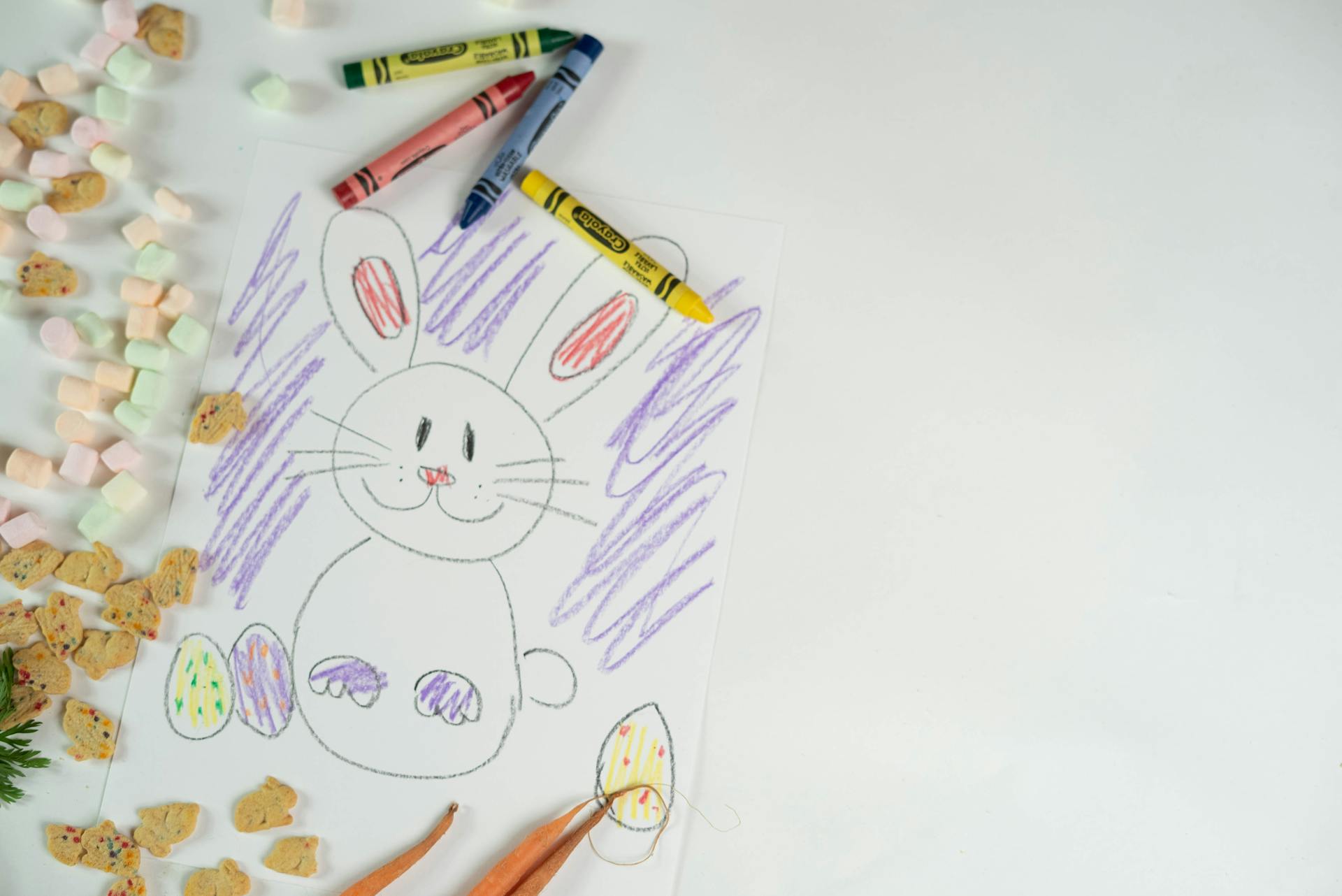
Crate training can be a game-changer for dogs, especially for new puppies. Crate training helps with housetraining by giving dogs a designated area to hold their bladder and bowels until they can be taken out.
Dogs can be left alone in their crates for short periods of time, which can help with separation anxiety and destructive behavior. In fact, crate training can reduce the likelihood of destructive behavior by 70% when dogs are left alone.
Some dogs may take to crate training more easily than others, but with patience and consistency, most dogs can learn to love their crates. Crate training can also help with noise reduction and prevent unwanted guests from entering the home.
Crate size is crucial, and dogs should have enough room to stand up, turn around, and lie down comfortably. A crate that's too small can lead to health problems and discomfort for your dog.
If this caught your attention, see: Does Spaying a Dog Help with Aggression
Preparing for Crate Training
Choosing the right crate is key, so make sure to get one that's durable, comfortable, and flexible with whatever training you're doing. A crate that's too big can be overwhelming for your dog, so buy the right size for their adult size and consider getting a divider to give them more space as they grow.
To establish a positive mindset for crate training, start by bringing your dog into the crate when they're calm, not when they're playing. This will help them associate the crate with a relaxed mindset. Begin with short sessions of 10 minutes and gradually increase the time.
You'll also need some essential supplies to make your dog's crate a happy place. These include bedding, treats, and toys. For puppies or older dogs still in need of housetraining, a simple crate mat is a good choice. Treats like Wellness Soft Puppy Bites Lamb & Salmon Recipe Grain-Free Dog Treats can help reinforce the idea that good things happen inside the crate. Busy toys like the KONG Classic can keep your dog focused and happy until they drift off to sleep.
Establish the Right Mindset
Establishing the right mindset is crucial for crate training to be a success. Your dog needs to associate the crate with a relaxed and comfortable space, not a punishment or confinement.
To start, you want to introduce the crate gradually, without rushing your dog to adjust to it before you leave them in it alone. This will help them settle into the crate on their own terms. Dogs typically prefer protected areas when bedding down, so a crate can tap into that natural inclination to rest in a safe space.
As you bring your dog into the crate, make sure to do so when they're calm. This will help them view the crate as a place of rest. Start by bringing them in for 10 minutes at a time and work your way up from there.
Crates can be a lifesaver in emergencies, allowing you to evacuate your dog efficiently and reducing the chance of them getting lost or injured. It's also essential for senior dogs, who may need a restful place to rest their joints or take frequent naps.
A fresh viewpoint: Does Getting a Dog Fixed Help with Aggression
Here are some tips to help you establish the right mindset for crate training:
- Introduce the crate gradually to avoid stressing your dog
- Bring your dog into the crate when they're calm
- Start with short sessions (10 minutes) and gradually increase the time
- Make the crate a comfortable and welcoming space for your dog
By following these tips and establishing the right mindset, you'll be well on your way to successful crate training.
Supplies Needed
To set up a crate that your dog will love, you'll need a few essential supplies. First and foremost, you'll need a crate that's the right size for your dog. As Flayton advises, choose a crate that's durable, comfortable, and flexible with whatever training you're doing.
When it comes to choosing the right type of crate, you have two options: hard plastic airline-style crates or wire crates. Most pups can learn to be comfortable in either type, but wire crates have more versatility when it comes to door placement and customizing the size of the interior with a divider.
A crate mat is also a must-have for your dog's comfort. Opt for a simple crate mat like the Frisco Micro Terry Dog Crate Mat, which is a good choice for pups still acclimating to the crate.
Discover more: Dog Crate Size for Corgi
Treats are another essential item for crate training. Small savory treats, like Wellness Soft Puppy Bites Lamb & Salmon Recipe Grain-Free Dog Treats, help reinforce the idea that good things happen inside the crate.
Toys can also be helpful in keeping your dog occupied and happy in the crate. Busy toys like the KONG Classic or a West Paw Zogoflex Small Tux Tough Treat Dispensing Dog Chew Toy can be filled with treats to keep your dog engaged.
Here's a list of the supplies you'll need to get started with crate training:
- Crate (hard plastic or wire)
- Crate mat
- Treats (small savory treats)
- Busy toys (e.g. KONG Classic, West Paw Zogoflex Small Tux Tough Treat Dispensing Dog Chew Toy)
Where to Store
When choosing a location for crate training, it's essential to select an area that is quiet and free from distractions. This will help your dog associate the crate with a calm environment.
A good spot to store the crate is in a corner of a room, away from high-traffic areas and noise sources.
The crate should be placed in a location where your dog can easily access it, such as near their bed or in a common living area.
Avoid placing the crate near your dog's food and water bowls to prevent them from associating the crate with mealtimes.
In a small apartment or living space, consider placing the crate in a room with a door that can be closed to help your dog feel secure.
A fresh viewpoint: Dog Grooming Room
Introducing Crate Training
Introducing crate training is a crucial step in getting your dog comfortable with the crate. Start by placing the crate in a high-traffic area of your home, such as the family room, and add a soft blanket or bed inside.
The goal is to make the crate a welcoming space for your dog, so be sure to keep the door open and let them explore at their own pace. Toss a treat inside and praise your dog when they go in to eat it, then give them another while they're in the crate. You can also entice your dog with a busy toy stuffed with treats.
Don't force your dog to enter the crate if they're not interested. Instead, try tossing treats just inside the door, and gradually move them further inside. If your dog is hesitant to go inside, give them treats to reward small steps towards the crate, such as glancing at it or taking a step towards it.
Curious to learn more? Check out: Are Service Dogs Allowed Everywhere
Here are some tips to keep in mind as you introduce crate training:
- Always give your dog a potty break before putting them in the crate.
- Don't crate your dog for too long, as this can lead to accidents.
- Feeding your dog's meals in their crate with the door open can help make it a positive space.
- Remember to praise and reward your dog for entering the crate calmly.
By following these steps and tips, you can help your dog feel comfortable and secure in their crate.
Training and Safety
You'll need to be patient with crate training, as it can take at least six months for your dog to adjust. This process isn't linear, so be prepared for ups and downs.
Dogs should never have dog collars or tags on when they're in the crate, as the tag could get caught and cause strangulation.
Potential Problems
Whining can be a challenge when crate training your dog at night. If your dog whines or cries, it may be difficult to decide whether they need to be let out to eliminate or just want attention. Ignore the whining, as punishing them for it can create more problems.
If the whining continues, try using the phrase associated with going outside to eliminate. If your dog responds and becomes excited, take them outside. This should be a trip with a purpose, not play time. Stand in one spot in your yard where they normally go to the bathroom and wait.
Take a look at this: Crate Training Puppies and Whining
You should also be aware that crate training won't solve separation anxiety problems. A crate may prevent destructive behavior, but your dog may get injured trying to escape. If you suspect your dog has separation anxiety, consider consulting a professional animal-behavior specialist for help.
Crates are meant to be temporary, so be sure to give your dog breaks outside the crate to play, eat, and use the bathroom. Dogs don't want to soil where they sleep, but if there's too long of a stretch without a walk, they might end up doing so.
Explore further: Why Are Dachshunds so Stubborn
Keep Your Dog Safe
Dogs should never, ever have dog collars or tags or anything on when they're in the crate, as this can pose a strangulation risk.
Removing your dog's collar and tags before crate time is a simple yet crucial step in keeping your dog safe.
Play Games
Play Games is a great way to create a positive association with the crate. Incorporate the crate into fun games where your dog goes in and out of the open crate at their own will.
Additional reading: Crate Training Games
Flayton likes to throw the ball in the crate when playing fetch, making it a fun and engaging experience for the dog. This helps the dog see the crate as a positive place.
Hide treats inside the crate for your dog to find, making it a game of sniffing and problem-solving. This game is a great way to encourage your dog to enter the crate willingly.
By incorporating the crate into play, you can help your dog feel more comfortable and secure in the space.
Success and Challenges
Crate training can be a game-changer for dogs, but it's not without its challenges.
The biggest success factor in crate training is making it a positive experience for your dog. Try feeding them meals or treats in their crate so crate time feels like a reward.
Leaving your dog in their crate all day can be detrimental to their mental and physical health, so be sure to limit their crate time based on their age, level of house training, and daily routine.
A unique perspective: Why Are Dachshunds so Needy
If you're new to crate training, it's essential to do your research and understand the process. Consulting a dog trainer can be super helpful if you have questions or need guidance.
Sticking to your plan is crucial for crate training success, so make sure to set clear goals and be consistent in your approach.
Frequently Asked Questions
Is it better to crate train a dog or not?
Crate training can provide a sense of security and calm for dogs, but it's not a one-size-fits-all solution and should be considered in conjunction with proper training and socialization. Whether crate training is right for your dog depends on their individual needs and personality.
Do vets recommend crate training?
Yes, most veterinarians recommend crate training dogs from a young age to aid in housebreaking and prevent accidents. Crate training helps puppies learn to hold their bladders and sleep in a clean environment.
Is it okay to crate a dog all night?
Crate time should be limited to prevent boredom, depression, and anxiety. Crating a dog all night can lead to negative effects on their mental and emotional well-being.
Is crate training stressful for dogs?
Crate training can be stressful for dogs, especially those with a history of kennel life or crate anxiety. Understanding the root causes can help you tailor a gentle approach to crate training and create a positive experience for your dog.
Should I put my 8 week old puppy in a crate at night?
Yes, crate training your 8-week-old puppy at night can help them feel relaxed and settled in their new home. Crate training from an early age can also establish good habits and prevent unwanted behaviors.
Sources
- https://www.humanesociety.org/resources/crate-training-101
- https://www.akc.org/expert-advice/training/how-to-crate-train-your-dog-in-9-easy-steps/
- https://be.chewy.com/how-to-crate-train-a-puppy-a-step-by-step-guide-from-an-expert/
- https://www.akc.org/expert-advice/training/why-crate-training-is-great-for-your-dog/
- https://www.playtimepaws.com/crate-training-how-why/
Featured Images: pexels.com


